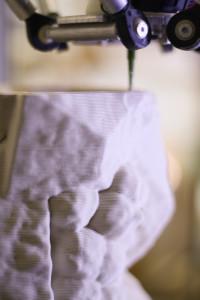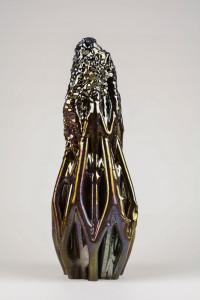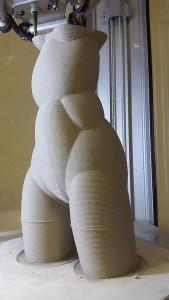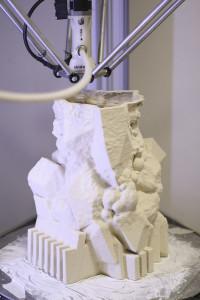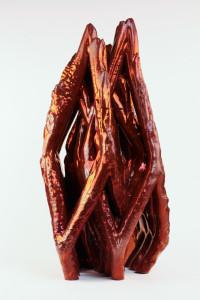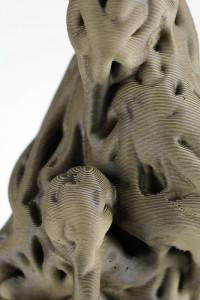Using paste extruders to 3D print in clay and ceramics is a rapidly growing trend due to the ability to create objects that are virtually impossible to make using traditional methods, giving ceramic artists entirely new ways to produce amazing pieces. But the process carries with it several risks, problems and limitations that most additive manufacturing technology doesn’t. Because clay materials are softer and take longer to dry, many objects are at risk of drying out, shrinking or cracking before they can be properly fired. There are also more limitations on print geometry because using support material isn’t really an option for clay materials, which could cause printed objects to collapse onto themselves.
3D printer manufacturer WASP has developed a new LDM (Liquid Deposition Modeling) clay or paste extruder that has solved many of the technical problems associated with printing with paste materials, but there are still challenges that need to be overcome. The Italian company is hoping that by collaborating with artist and ceramic 3D printing educator Francesco Pacelli they can figure out exactly why some of the prints fail and how it can be prevented. He has been testing out the abilities and limitations of the WASP delta style 3D printer equipped with their LDM extruder and showing off some of the amazing ceramic designs that he’s created on his website.
Pacelli has been using LDM 3D printers while working as an educator and academic researcher at Politecnico di Milano’s LAB+ 3D printing lab, so WASP went to the right guy to collaborate. According to Pacelli, the actual clay material and the way that it is handled and mixed is the key to making the paste extrusion technology work, and he’s exploring several different types of ceramics to widen the amount of clay materials available as 3D printing media. He is also experimenting with different mixtures, textures and printing parameters for the LDM process and has found some surprising solutions to many of the more common problems.
Through his research and knowledge of clay materials, Pacelli has discovered that Limoges porcelain, a hard paste material from the Limoges area of France, benefits from two high-temperature firings. The first biscuit firing at 980°C sets the material, making it harder and more receptive to glaze which results in the second firing at at 1250°C producing a better finish once the transparent glaze is applied. He also discovered that stoneware material made from Sibelco clay can actually be 3D printed, however because it is a rough, solid material it needs extra water to flow out of the extruder correctly.
- 3D printing with stoneware material.
- Printing with maiolica ceramic.
- Printing with Limoges porcelain.
Pacelli also found that he was able to produce excellent results with an unconventional material called maiolica, which is a green clay that turns pale red after it has been fired. It is primarily used to make thin ceramics with tin or metallic glazes that result in extremely bright and sharp colors. The material is extremely sticky, so it is very difficult to extrude without making sure that it is mixed with a lot of water. Unfortunately that leaves any objects printed in the material fragile and subject to drying, cracking and collapsing due to shrinkage as the extra liquid dries. However Pacelli discovered that covering freshly printed objects with plastic bags will maintain the correct humidity level needed to prevent drying or cracking while waiting to be fired.
- Pyromania printed in ceramic.
- Robotic Woman Nursing Baby in ceramic.
- Robotic Woman Nursing Baby in ceramic detail.
The smart LDM extruder that was developed by WASP is able to maintain a strict control over the flow of clay material because a compressed air tank feeds the material into an endless screw. The process is all controlled with a stepper motor which helps to insure that the flow is always consistent. This will prevent air bubbles, deformations and other glitches that can cause a ceramic or clay print to collapse or fail.
Here is some video of the WASP Delta 3D printer outfitted with a LDM extruder:
The collaboration between Pacelli and WASP is an ongoing project that will continue to develop new printing materials and identify ideal printing parameters for individual ceramics and clays. You can already see some examples of the amazing ceramic pieces created by Pacelli on his website, and WASP says that they will be sharing even more ceramic creations and results from their experiments in the coming weeks. Tell us your thoughts on this new extruder in the WASP New 3D Printing Extruder forum over at 3DPB.com.
Subscribe to Our Email Newsletter
Stay up-to-date on all the latest news from the 3D printing industry and receive information and offers from third party vendors.
Print Services
Upload your 3D Models and get them printed quickly and efficiently.
You May Also Like
Heating Up: 3D Systems’ Scott Green Discusses 3D Printing’s Potential in the Data Center Industry
The relentless rise of NVIDIA, the steadily increasing pledges of major private and public investments in national infrastructure projects around the world, and the general cultural obsession with AI have...
3DPOD 260: John Hart on VulcanForms, MIT, Desktop Metal and More
John Hart is a Professor at MIT; he´s also the director of the Laboratory for Manufacturing and Productivity as well as the director of the Center for Advanced Production Technologies....
Etsy Design Rule Change Reduces Selection of 3D Printed Goods
Online marketplace Etsy has implemented a rule change requiring all 3D printed goods on the site to be original designs. The update to the site’s Creativity Standards states, ¨Items produced using...
E-Beam OEM Wayland Additive Partners with USC Racing to 3D Print Titanium Exhaust Collector
Every year, standards organization SAE International holds a competition called Formula SAE, in which students from both undergraduate and graduate programs design, build, and race small formula-style race cars. For...


